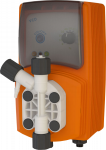Home Filtration Technology Chlorine
Chlorine
Chlorine and its compounds are in terms of water hygienic security significant substances for minimizing or avoiding the occurrence of water distributable infectious diseases. Disinfection of water with chlorine or also the water chlorination, is a process, which even in small chlorine concentrations effectively eliminates any microbiological and biological contamination. Not only because chlorine is effective against most bacteria and viruses present in water, but also for economic reasons, chlorination of water belongs to the most common methods of water disinfection used in water management infrastructures, industrial processes, swimming pools, wells, boreholes and other water sources.
Disinfection with chlorine, is besides other things, often carried out by dosing sodium hypochlorite (NaClO), which may be in solid or liquid form. It can be applied at once as a shock dose (pool, well, etc.), or in proportion to the water flow and current pH value with the help of dosing pumps. Free chlorine content in drinking water determines the Ministry of Health Decree no. 83/2014 Coll. the limit of 0.30 mg/l.

Water disinfection by chlorination can be problematic under certain circumstances. Leaving aside the negative sensory properties of chlorinated water, therefore the unpleasant taste and odor, it should be pointed out that chlorine in drinking water kills not only bacteria, but also reacts with natural organic compounds naturally occurring in the water. This reaction produces substances known as "disinfection byproducts". This includes a broad group of substances, which we are yet not able to identify all, despite the many of this group are known to have potential toxic or carcinogenic properties. Most of them are trihalomethanes and haloacetic acids. The World Health Organization however claims that "the health risks associated with water disinfection by-products are extremely low in comparison with inadequate water disinfection".
The appropriate way for the chlorine removal (water dechlorination) is to use an activated carbon, which is filled into the filters of different sizes, from a removable cartridge filters on a small piping, to a large volume industrial containers.
Activated carbon is the adsorbent filter material produced from coconut shells, wood or coal. Its high sorption capacity allows to capture chlorine and the other chlorination byproducts, together with organic solvents, toxic heavy metals and other pollutants on its exceptionally high internal surface area (400 - 1500 m2/g). In a dechlorination unit, the water flows through a bed of activated carbon, whis captures these undesirable substances on its surface. After the exhaustion of sorption properties, activated carbon filling has to be regenerated (reactivation) by backwashing, or exchanged for a fresh one.


